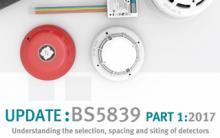BS 5839: What’s New?
BS 5839: What’s New?
On 1st September 2017, BS 5839-1 2017 was released. The revised standard includes 25 changes to 14 existing clauses; the key changes will be discussed in this article.
Call Point Covers
The biggest change, and the one that everyone is talking about, is the recommendation for call point covers. Going forward, all call points should be installed with a call point cover. The standard does not specify whether existing installations should be updated to include call point covers, however if an existing installation doesn’t have call point covers and the risk assessment indicates they are not required, it would be best practice to record this as a variation in the fire detection log book.
Multi-sensors
The definition of a ‘multi-sensor’ has been somewhat in dispute in recent years. Under section 3, in the Terms and Definitions, clause 3.40 defines a multi-sensor as, a “fire detector that monitors more than one physical and/ or chemical phenomenon associated with fire”. If you read on through the standard, it acknowledges that a multi-sensor could be; optical and heat, CO and heat, or smoke, heat and CO2. The standard does however accept that a multi-sensor can also be used in a single sensor state. Whichever state the multi-sensor is being used in, the detector should meet the performance requirements of the appropriate part of BS EN 54. The standard also explains that the testing of a multi-sensor can be carried out with the application of modern sensor test equipment.
Video Fire Detection
Technology continues to develop at a phenomenal rate, as such, video fire detection is now a recognised specialised fire detection technique, specifically for L5 and P2 consultant specified categories.
Annexe E
Annexe E details the correct procedure for the selection of detector type, to reduce false alarms.
In a further attempt to reduce false alarms, Annexe E also recommends;
- The use of staff alarms to validate a fire alarm and avoid unnecessary mass evacuation and/or fire service call outs.
- Linking fire alarm systems to security alarms to ensure that the responsible person is notified, even when there is no-one in the office at night. However, it is important to ensure that the battery capacity of the security alarm is equal to that of the fire alarm.
- The deactivation of the connection to the alarm receiving centre (ARC) during maintenance to avoid unnecessary call outs.
PD6669:2017
BS 5839-1 2017 also makes reference to PD6669:2017, which builds upon the existing BS EN 50136; in which, new alarm transmission system (ATS) categories, SP3+ and DP2+, have been introduced.
SP3+ has a primary ATP reporting time of 10 minutes, a catastrophic failure reporting time of 10 minutes and an ATS reporting time of 10 minutes.
DP2+ has a primary ATP reporting time of 10 minutes, a catastrophic failure reporting time of 11 minutes and an ATS reporting time of 20 minutes.
We hope this quick reference to the changes incorporated into BS 5839-1 2017 has been useful, however it should not be used as a substitute to the British Standard Document. There are several other changes that have not been included in this blog, therefore please refer to BSI for full details.

